Comprehensive Business Analysis: London Underground Operations
VerifiedAdded on 2022/08/13
|6
|1826
|81
Report
AI Summary
This report provides a detailed business analysis of the London Underground, a wholly-owned subsidiary of Transport for London and a vital part of London's public transport system. The report begins with an overview of the company, its history, and its role in the city. It then delves into the types of organizations, classifying the London Underground as a public-private partnership. The organizational structure is examined, highlighting key departments and management. The core of the analysis focuses on the generic marketing mix (product, price, place, and promotion) of the London Underground, detailing its services, pricing strategies, network presence, and promotional activities. Furthermore, the report identifies and analyzes the various stakeholders, including customers, employees, government, suppliers, and shareholders. The report concludes with recommendations for improving profitability and expansion, particularly in the northern and southern parts of London, based on the provided business analysis.
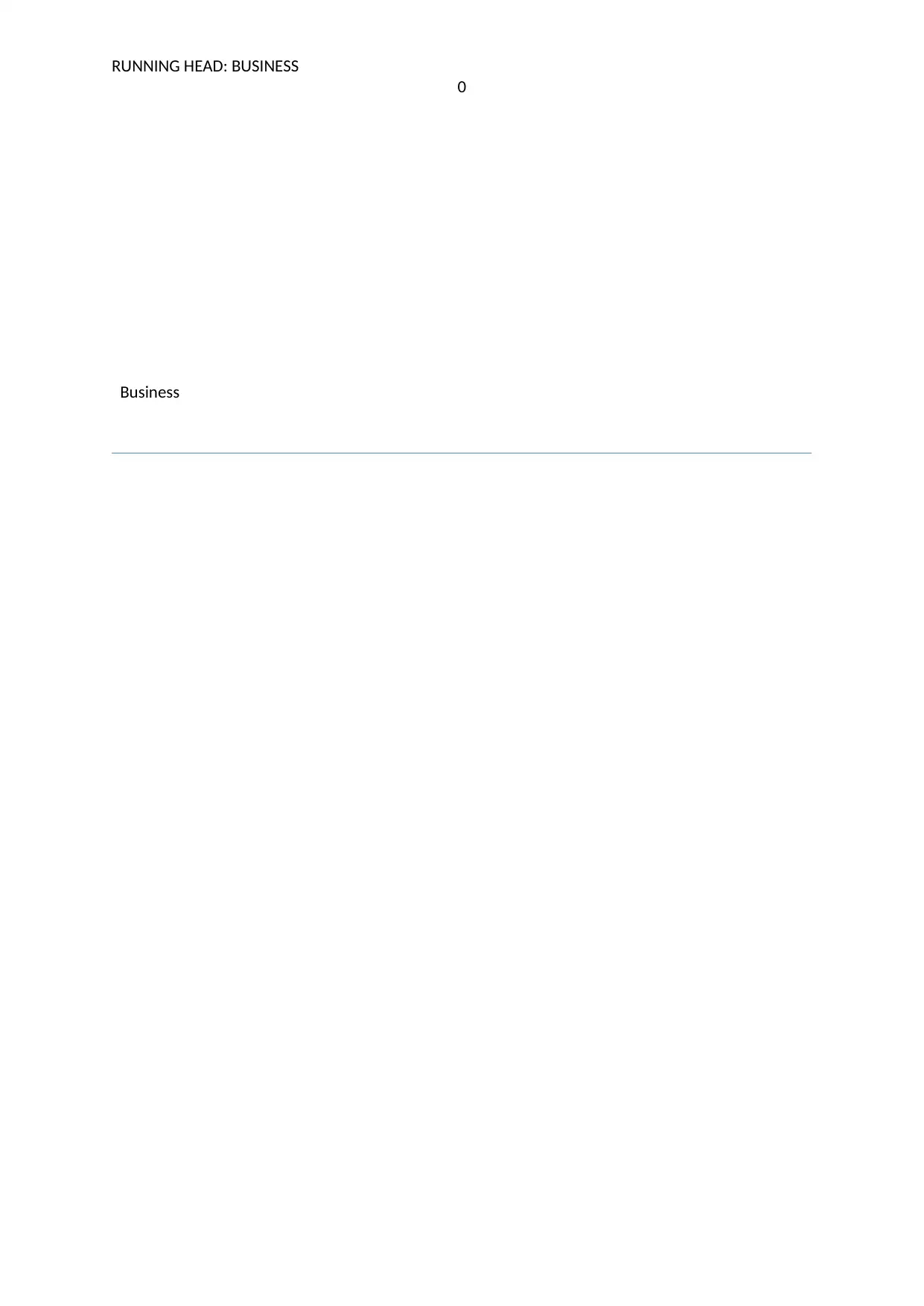
RUNNING HEAD: BUSINESS
0
Business
0
Business
Paraphrase This Document
Need a fresh take? Get an instant paraphrase of this document with our AI Paraphraser
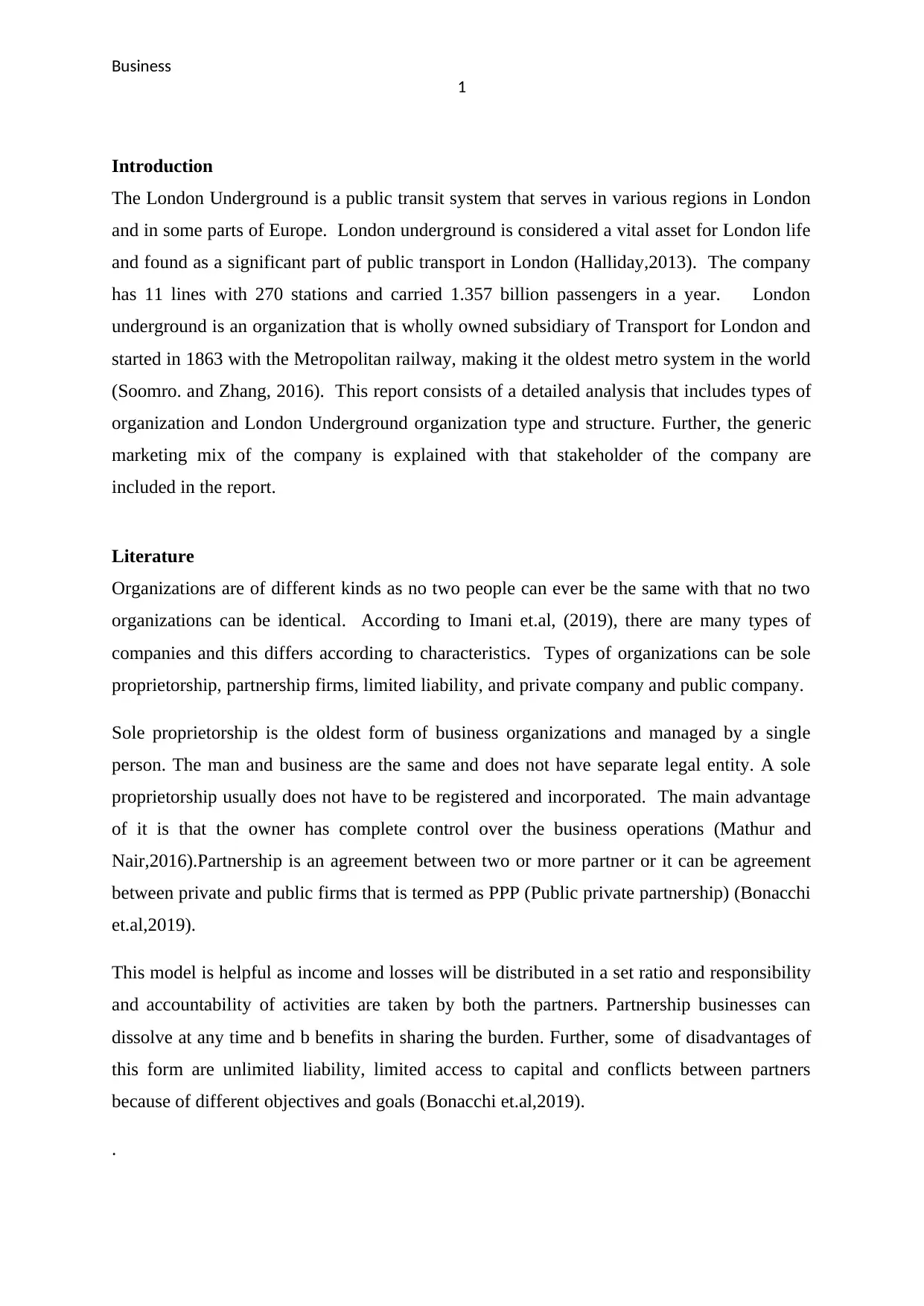
Business
1
Introduction
The London Underground is a public transit system that serves in various regions in London
and in some parts of Europe. London underground is considered a vital asset for London life
and found as a significant part of public transport in London (Halliday,2013). The company
has 11 lines with 270 stations and carried 1.357 billion passengers in a year. London
underground is an organization that is wholly owned subsidiary of Transport for London and
started in 1863 with the Metropolitan railway, making it the oldest metro system in the world
(Soomro. and Zhang, 2016). This report consists of a detailed analysis that includes types of
organization and London Underground organization type and structure. Further, the generic
marketing mix of the company is explained with that stakeholder of the company are
included in the report.
Literature
Organizations are of different kinds as no two people can ever be the same with that no two
organizations can be identical. According to Imani et.al, (2019), there are many types of
companies and this differs according to characteristics. Types of organizations can be sole
proprietorship, partnership firms, limited liability, and private company and public company.
Sole proprietorship is the oldest form of business organizations and managed by a single
person. The man and business are the same and does not have separate legal entity. A sole
proprietorship usually does not have to be registered and incorporated. The main advantage
of it is that the owner has complete control over the business operations (Mathur and
Nair,2016).Partnership is an agreement between two or more partner or it can be agreement
between private and public firms that is termed as PPP (Public private partnership) (Bonacchi
et.al,2019).
This model is helpful as income and losses will be distributed in a set ratio and responsibility
and accountability of activities are taken by both the partners. Partnership businesses can
dissolve at any time and b benefits in sharing the burden. Further, some of disadvantages of
this form are unlimited liability, limited access to capital and conflicts between partners
because of different objectives and goals (Bonacchi et.al,2019).
.
1
Introduction
The London Underground is a public transit system that serves in various regions in London
and in some parts of Europe. London underground is considered a vital asset for London life
and found as a significant part of public transport in London (Halliday,2013). The company
has 11 lines with 270 stations and carried 1.357 billion passengers in a year. London
underground is an organization that is wholly owned subsidiary of Transport for London and
started in 1863 with the Metropolitan railway, making it the oldest metro system in the world
(Soomro. and Zhang, 2016). This report consists of a detailed analysis that includes types of
organization and London Underground organization type and structure. Further, the generic
marketing mix of the company is explained with that stakeholder of the company are
included in the report.
Literature
Organizations are of different kinds as no two people can ever be the same with that no two
organizations can be identical. According to Imani et.al, (2019), there are many types of
companies and this differs according to characteristics. Types of organizations can be sole
proprietorship, partnership firms, limited liability, and private company and public company.
Sole proprietorship is the oldest form of business organizations and managed by a single
person. The man and business are the same and does not have separate legal entity. A sole
proprietorship usually does not have to be registered and incorporated. The main advantage
of it is that the owner has complete control over the business operations (Mathur and
Nair,2016).Partnership is an agreement between two or more partner or it can be agreement
between private and public firms that is termed as PPP (Public private partnership) (Bonacchi
et.al,2019).
This model is helpful as income and losses will be distributed in a set ratio and responsibility
and accountability of activities are taken by both the partners. Partnership businesses can
dissolve at any time and b benefits in sharing the burden. Further, some of disadvantages of
this form are unlimited liability, limited access to capital and conflicts between partners
because of different objectives and goals (Bonacchi et.al,2019).
.
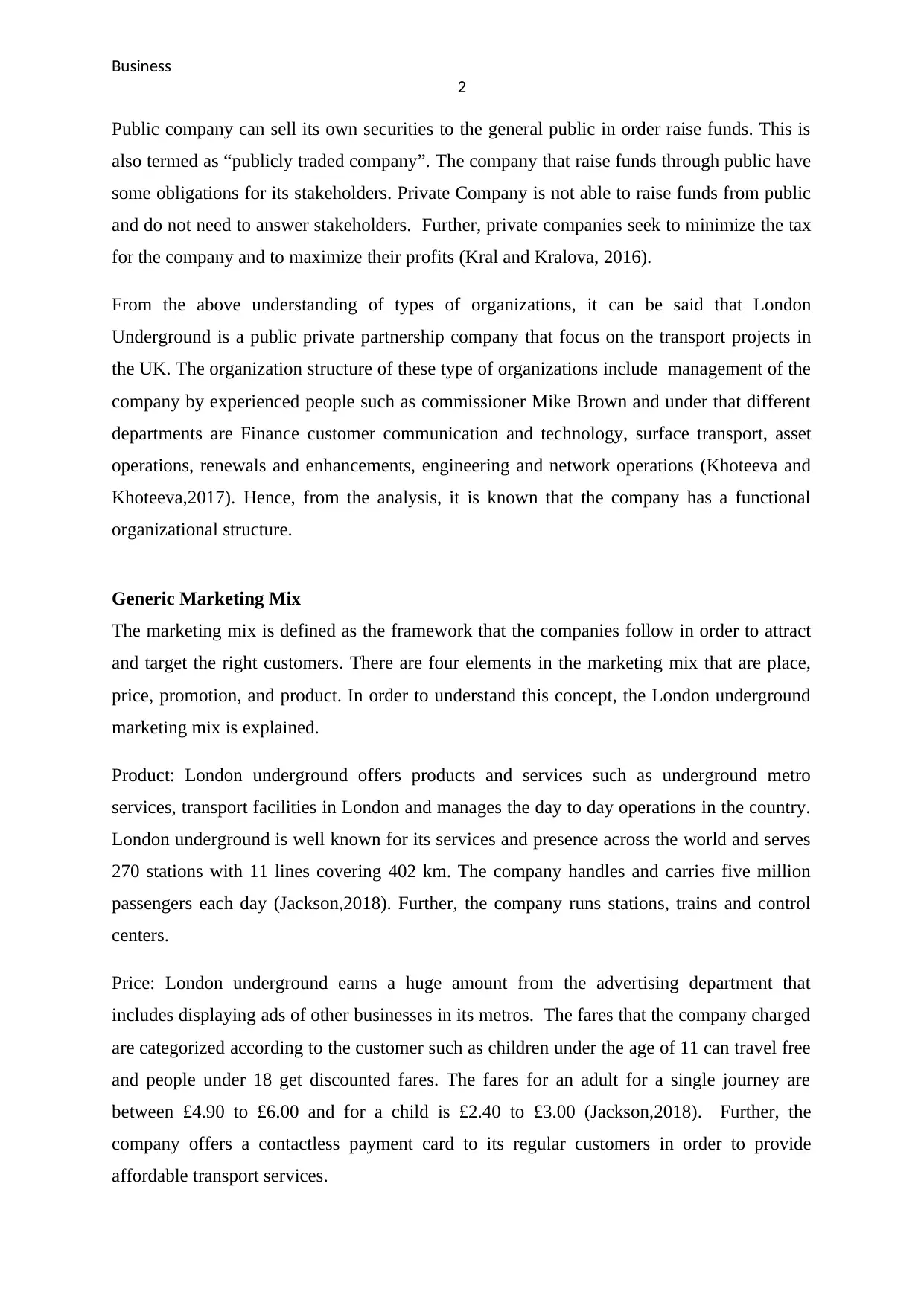
Business
2
Public company can sell its own securities to the general public in order raise funds. This is
also termed as “publicly traded company”. The company that raise funds through public have
some obligations for its stakeholders. Private Company is not able to raise funds from public
and do not need to answer stakeholders. Further, private companies seek to minimize the tax
for the company and to maximize their profits (Kral and Kralova, 2016).
From the above understanding of types of organizations, it can be said that London
Underground is a public private partnership company that focus on the transport projects in
the UK. The organization structure of these type of organizations include management of the
company by experienced people such as commissioner Mike Brown and under that different
departments are Finance customer communication and technology, surface transport, asset
operations, renewals and enhancements, engineering and network operations (Khoteeva and
Khoteeva,2017). Hence, from the analysis, it is known that the company has a functional
organizational structure.
Generic Marketing Mix
The marketing mix is defined as the framework that the companies follow in order to attract
and target the right customers. There are four elements in the marketing mix that are place,
price, promotion, and product. In order to understand this concept, the London underground
marketing mix is explained.
Product: London underground offers products and services such as underground metro
services, transport facilities in London and manages the day to day operations in the country.
London underground is well known for its services and presence across the world and serves
270 stations with 11 lines covering 402 km. The company handles and carries five million
passengers each day (Jackson,2018). Further, the company runs stations, trains and control
centers.
Price: London underground earns a huge amount from the advertising department that
includes displaying ads of other businesses in its metros. The fares that the company charged
are categorized according to the customer such as children under the age of 11 can travel free
and people under 18 get discounted fares. The fares for an adult for a single journey are
between £4.90 to £6.00 and for a child is £2.40 to £3.00 (Jackson,2018). Further, the
company offers a contactless payment card to its regular customers in order to provide
affordable transport services.
2
Public company can sell its own securities to the general public in order raise funds. This is
also termed as “publicly traded company”. The company that raise funds through public have
some obligations for its stakeholders. Private Company is not able to raise funds from public
and do not need to answer stakeholders. Further, private companies seek to minimize the tax
for the company and to maximize their profits (Kral and Kralova, 2016).
From the above understanding of types of organizations, it can be said that London
Underground is a public private partnership company that focus on the transport projects in
the UK. The organization structure of these type of organizations include management of the
company by experienced people such as commissioner Mike Brown and under that different
departments are Finance customer communication and technology, surface transport, asset
operations, renewals and enhancements, engineering and network operations (Khoteeva and
Khoteeva,2017). Hence, from the analysis, it is known that the company has a functional
organizational structure.
Generic Marketing Mix
The marketing mix is defined as the framework that the companies follow in order to attract
and target the right customers. There are four elements in the marketing mix that are place,
price, promotion, and product. In order to understand this concept, the London underground
marketing mix is explained.
Product: London underground offers products and services such as underground metro
services, transport facilities in London and manages the day to day operations in the country.
London underground is well known for its services and presence across the world and serves
270 stations with 11 lines covering 402 km. The company handles and carries five million
passengers each day (Jackson,2018). Further, the company runs stations, trains and control
centers.
Price: London underground earns a huge amount from the advertising department that
includes displaying ads of other businesses in its metros. The fares that the company charged
are categorized according to the customer such as children under the age of 11 can travel free
and people under 18 get discounted fares. The fares for an adult for a single journey are
between £4.90 to £6.00 and for a child is £2.40 to £3.00 (Jackson,2018). Further, the
company offers a contactless payment card to its regular customers in order to provide
affordable transport services.
⊘ This is a preview!⊘
Do you want full access?
Subscribe today to unlock all pages.

Trusted by 1+ million students worldwide
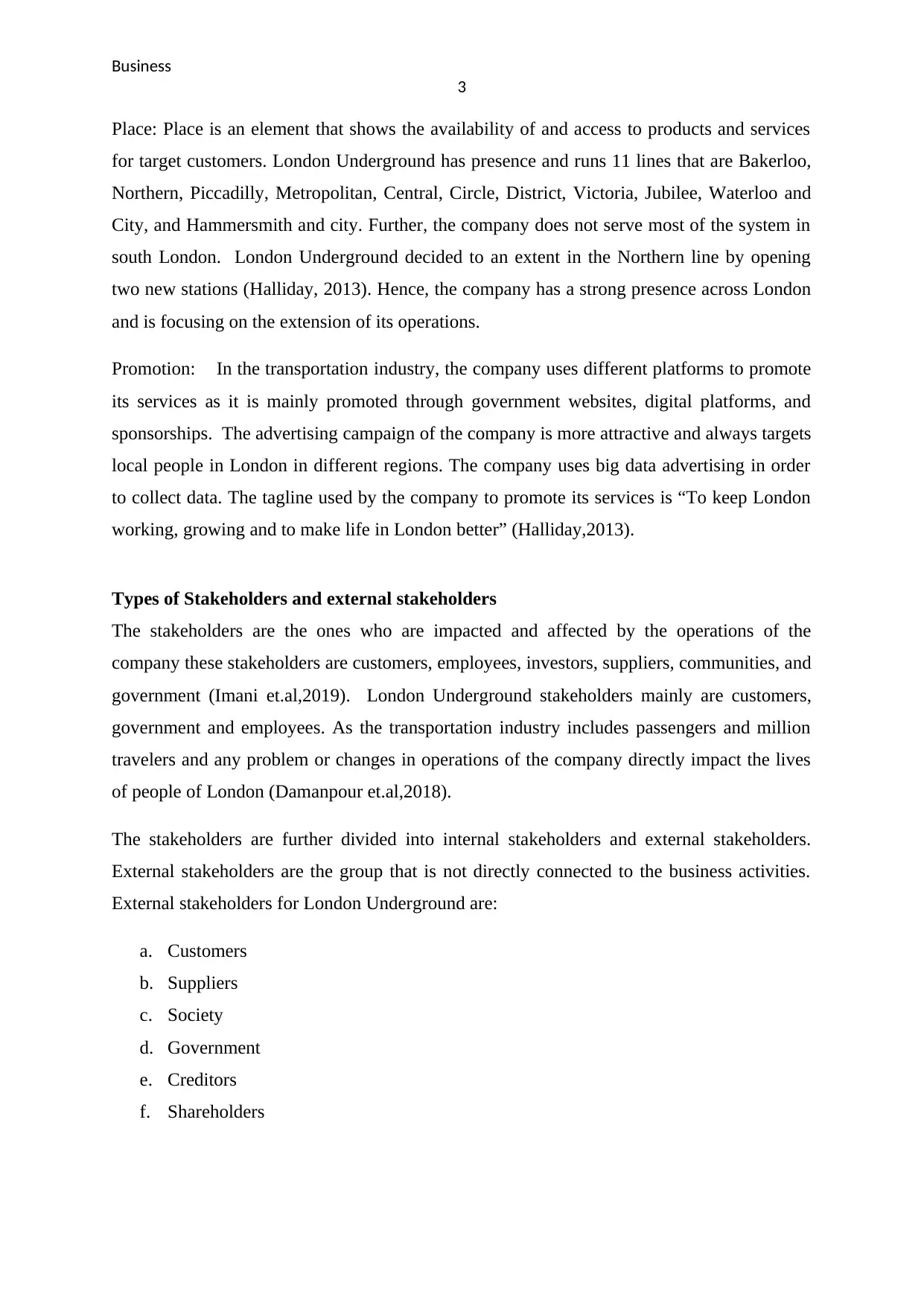
Business
3
Place: Place is an element that shows the availability of and access to products and services
for target customers. London Underground has presence and runs 11 lines that are Bakerloo,
Northern, Piccadilly, Metropolitan, Central, Circle, District, Victoria, Jubilee, Waterloo and
City, and Hammersmith and city. Further, the company does not serve most of the system in
south London. London Underground decided to an extent in the Northern line by opening
two new stations (Halliday, 2013). Hence, the company has a strong presence across London
and is focusing on the extension of its operations.
Promotion: In the transportation industry, the company uses different platforms to promote
its services as it is mainly promoted through government websites, digital platforms, and
sponsorships. The advertising campaign of the company is more attractive and always targets
local people in London in different regions. The company uses big data advertising in order
to collect data. The tagline used by the company to promote its services is “To keep London
working, growing and to make life in London better” (Halliday,2013).
Types of Stakeholders and external stakeholders
The stakeholders are the ones who are impacted and affected by the operations of the
company these stakeholders are customers, employees, investors, suppliers, communities, and
government (Imani et.al,2019). London Underground stakeholders mainly are customers,
government and employees. As the transportation industry includes passengers and million
travelers and any problem or changes in operations of the company directly impact the lives
of people of London (Damanpour et.al,2018).
The stakeholders are further divided into internal stakeholders and external stakeholders.
External stakeholders are the group that is not directly connected to the business activities.
External stakeholders for London Underground are:
a. Customers
b. Suppliers
c. Society
d. Government
e. Creditors
f. Shareholders
3
Place: Place is an element that shows the availability of and access to products and services
for target customers. London Underground has presence and runs 11 lines that are Bakerloo,
Northern, Piccadilly, Metropolitan, Central, Circle, District, Victoria, Jubilee, Waterloo and
City, and Hammersmith and city. Further, the company does not serve most of the system in
south London. London Underground decided to an extent in the Northern line by opening
two new stations (Halliday, 2013). Hence, the company has a strong presence across London
and is focusing on the extension of its operations.
Promotion: In the transportation industry, the company uses different platforms to promote
its services as it is mainly promoted through government websites, digital platforms, and
sponsorships. The advertising campaign of the company is more attractive and always targets
local people in London in different regions. The company uses big data advertising in order
to collect data. The tagline used by the company to promote its services is “To keep London
working, growing and to make life in London better” (Halliday,2013).
Types of Stakeholders and external stakeholders
The stakeholders are the ones who are impacted and affected by the operations of the
company these stakeholders are customers, employees, investors, suppliers, communities, and
government (Imani et.al,2019). London Underground stakeholders mainly are customers,
government and employees. As the transportation industry includes passengers and million
travelers and any problem or changes in operations of the company directly impact the lives
of people of London (Damanpour et.al,2018).
The stakeholders are further divided into internal stakeholders and external stakeholders.
External stakeholders are the group that is not directly connected to the business activities.
External stakeholders for London Underground are:
a. Customers
b. Suppliers
c. Society
d. Government
e. Creditors
f. Shareholders
Paraphrase This Document
Need a fresh take? Get an instant paraphrase of this document with our AI Paraphraser
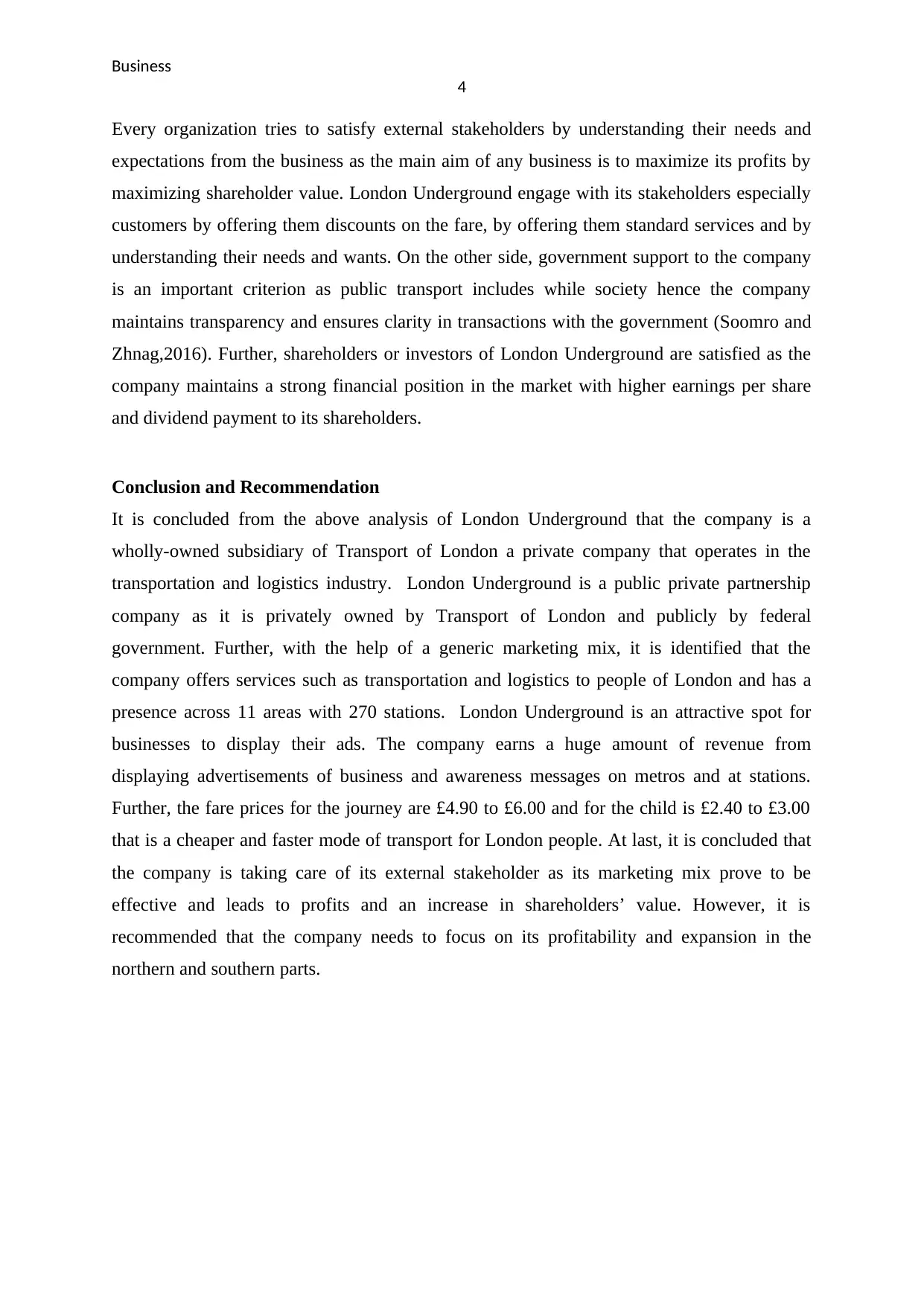
Business
4
Every organization tries to satisfy external stakeholders by understanding their needs and
expectations from the business as the main aim of any business is to maximize its profits by
maximizing shareholder value. London Underground engage with its stakeholders especially
customers by offering them discounts on the fare, by offering them standard services and by
understanding their needs and wants. On the other side, government support to the company
is an important criterion as public transport includes while society hence the company
maintains transparency and ensures clarity in transactions with the government (Soomro and
Zhnag,2016). Further, shareholders or investors of London Underground are satisfied as the
company maintains a strong financial position in the market with higher earnings per share
and dividend payment to its shareholders.
Conclusion and Recommendation
It is concluded from the above analysis of London Underground that the company is a
wholly-owned subsidiary of Transport of London a private company that operates in the
transportation and logistics industry. London Underground is a public private partnership
company as it is privately owned by Transport of London and publicly by federal
government. Further, with the help of a generic marketing mix, it is identified that the
company offers services such as transportation and logistics to people of London and has a
presence across 11 areas with 270 stations. London Underground is an attractive spot for
businesses to display their ads. The company earns a huge amount of revenue from
displaying advertisements of business and awareness messages on metros and at stations.
Further, the fare prices for the journey are £4.90 to £6.00 and for the child is £2.40 to £3.00
that is a cheaper and faster mode of transport for London people. At last, it is concluded that
the company is taking care of its external stakeholder as its marketing mix prove to be
effective and leads to profits and an increase in shareholders’ value. However, it is
recommended that the company needs to focus on its profitability and expansion in the
northern and southern parts.
4
Every organization tries to satisfy external stakeholders by understanding their needs and
expectations from the business as the main aim of any business is to maximize its profits by
maximizing shareholder value. London Underground engage with its stakeholders especially
customers by offering them discounts on the fare, by offering them standard services and by
understanding their needs and wants. On the other side, government support to the company
is an important criterion as public transport includes while society hence the company
maintains transparency and ensures clarity in transactions with the government (Soomro and
Zhnag,2016). Further, shareholders or investors of London Underground are satisfied as the
company maintains a strong financial position in the market with higher earnings per share
and dividend payment to its shareholders.
Conclusion and Recommendation
It is concluded from the above analysis of London Underground that the company is a
wholly-owned subsidiary of Transport of London a private company that operates in the
transportation and logistics industry. London Underground is a public private partnership
company as it is privately owned by Transport of London and publicly by federal
government. Further, with the help of a generic marketing mix, it is identified that the
company offers services such as transportation and logistics to people of London and has a
presence across 11 areas with 270 stations. London Underground is an attractive spot for
businesses to display their ads. The company earns a huge amount of revenue from
displaying advertisements of business and awareness messages on metros and at stations.
Further, the fare prices for the journey are £4.90 to £6.00 and for the child is £2.40 to £3.00
that is a cheaper and faster mode of transport for London people. At last, it is concluded that
the company is taking care of its external stakeholder as its marketing mix prove to be
effective and leads to profits and an increase in shareholders’ value. However, it is
recommended that the company needs to focus on its profitability and expansion in the
northern and southern parts.
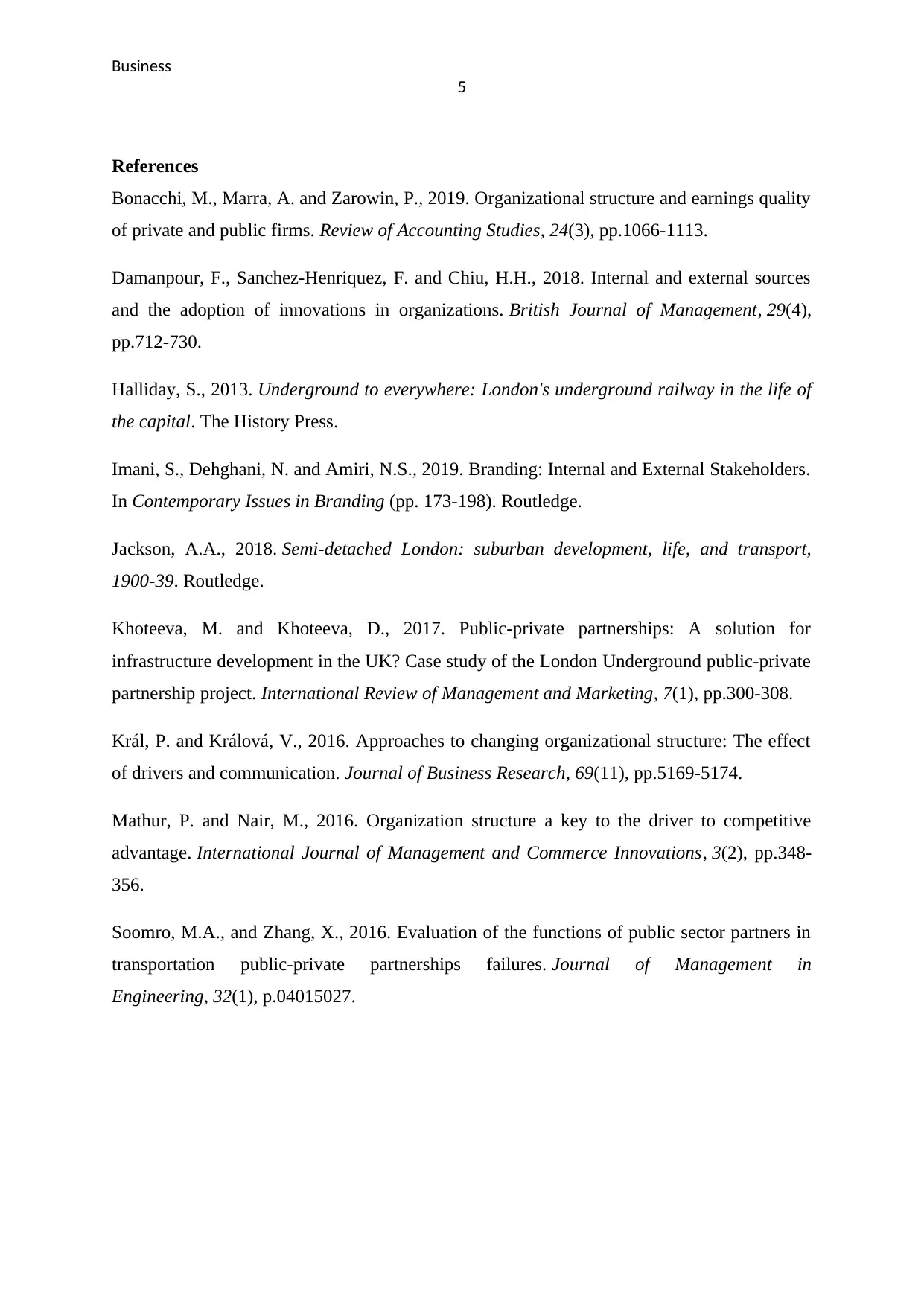
Business
5
References
Bonacchi, M., Marra, A. and Zarowin, P., 2019. Organizational structure and earnings quality
of private and public firms. Review of Accounting Studies, 24(3), pp.1066-1113.
Damanpour, F., Sanchez‐Henriquez, F. and Chiu, H.H., 2018. Internal and external sources
and the adoption of innovations in organizations. British Journal of Management, 29(4),
pp.712-730.
Halliday, S., 2013. Underground to everywhere: London's underground railway in the life of
the capital. The History Press.
Imani, S., Dehghani, N. and Amiri, N.S., 2019. Branding: Internal and External Stakeholders.
In Contemporary Issues in Branding (pp. 173-198). Routledge.
Jackson, A.A., 2018. Semi-detached London: suburban development, life, and transport,
1900-39. Routledge.
Khoteeva, M. and Khoteeva, D., 2017. Public-private partnerships: A solution for
infrastructure development in the UK? Case study of the London Underground public-private
partnership project. International Review of Management and Marketing, 7(1), pp.300-308.
Král, P. and Králová, V., 2016. Approaches to changing organizational structure: The effect
of drivers and communication. Journal of Business Research, 69(11), pp.5169-5174.
Mathur, P. and Nair, M., 2016. Organization structure a key to the driver to competitive
advantage. International Journal of Management and Commerce Innovations, 3(2), pp.348-
356.
Soomro, M.A., and Zhang, X., 2016. Evaluation of the functions of public sector partners in
transportation public-private partnerships failures. Journal of Management in
Engineering, 32(1), p.04015027.
5
References
Bonacchi, M., Marra, A. and Zarowin, P., 2019. Organizational structure and earnings quality
of private and public firms. Review of Accounting Studies, 24(3), pp.1066-1113.
Damanpour, F., Sanchez‐Henriquez, F. and Chiu, H.H., 2018. Internal and external sources
and the adoption of innovations in organizations. British Journal of Management, 29(4),
pp.712-730.
Halliday, S., 2013. Underground to everywhere: London's underground railway in the life of
the capital. The History Press.
Imani, S., Dehghani, N. and Amiri, N.S., 2019. Branding: Internal and External Stakeholders.
In Contemporary Issues in Branding (pp. 173-198). Routledge.
Jackson, A.A., 2018. Semi-detached London: suburban development, life, and transport,
1900-39. Routledge.
Khoteeva, M. and Khoteeva, D., 2017. Public-private partnerships: A solution for
infrastructure development in the UK? Case study of the London Underground public-private
partnership project. International Review of Management and Marketing, 7(1), pp.300-308.
Král, P. and Králová, V., 2016. Approaches to changing organizational structure: The effect
of drivers and communication. Journal of Business Research, 69(11), pp.5169-5174.
Mathur, P. and Nair, M., 2016. Organization structure a key to the driver to competitive
advantage. International Journal of Management and Commerce Innovations, 3(2), pp.348-
356.
Soomro, M.A., and Zhang, X., 2016. Evaluation of the functions of public sector partners in
transportation public-private partnerships failures. Journal of Management in
Engineering, 32(1), p.04015027.
⊘ This is a preview!⊘
Do you want full access?
Subscribe today to unlock all pages.

Trusted by 1+ million students worldwide
1 out of 6
Related Documents
Your All-in-One AI-Powered Toolkit for Academic Success.
+13062052269
info@desklib.com
Available 24*7 on WhatsApp / Email
![[object Object]](/_next/static/media/star-bottom.7253800d.svg)
Unlock your academic potential
Copyright © 2020–2025 A2Z Services. All Rights Reserved. Developed and managed by ZUCOL.



